Table of contents
Dental bridge is an effective solution for replacing missing teeth and restoring both function and appearance. If you are missing a tooth, it can often be restored with a dental bridge. A dental bridge is a custom-made appliance and is one of the most popular solutions for filling gaps between teeth, and treatment can be completed within a matter of weeks. The latest techniques and materials ensure that dental bridges can look exactly like real teeth, seamlessly restoring your ability to eat and talk with complete confidence and comfort.
A dental bridge replaces missing teeth. It can replace a single tooth or several teeth that were originally side by side. The bridge fills in the gap, and we can create an appliance that blends in with your natural teeth beautifully. A bridge consists of crowns that are fitted over the abutment teeth.
These are the teeth on each side of the gap. They are attached to pontics, artificial teeth that replace those missing. Each pontic is shaped like a natural tooth and sits on the gum. Dental bridges can also be implant-supported, fitting onto abutments attached to the implant screws inserted into the jawbone. An implant bridge is useful when no natural teeth are available or suitable to support an ordinary dental bridge.

Various dental bridges are available, depending on the location of the missing teeth, the number of teeth that must be replaced, and your unique oral health needs.
The table displays the most important factors for traditional fixed bridge, Maryland dental bridge, cantilever dental bridge, and implant-supported bridge.
| Factors | Traditional Fixed Bridge | Cantilever Dental Bridge | Maryland Dental Bridge | Implant-Supported Bridge |
|---|---|---|---|---|
| Survival rate | 90%-95% | 80%-85% | 85%-90% | 95%-100% |
| Strength | Strongest | Weaker than traditional bridge | Weakest | Strongest |
| Durability | Durable | Less durable than traditional bridge | Less durable than traditional bridge | Durable |
| Appearance | Natural-looking | Less natural-looking than traditional bridge | Less natural-looking than traditional bridge | Natural-looking |
| Cost | More expensive | Less expensive than traditional bridge | Less expensive | Most expensive |
| Invasiveness | Most invasive | Least invasive of the three bridges that require crowns | Least invasive | Least invasive |
| Recovery time | Longer recovery time | Shorter recovery time than traditional bridge | Shorter recovery time | Shorter recovery time |
* The best type of dental bridge for you will depend on your individual needs and preferences.
References:
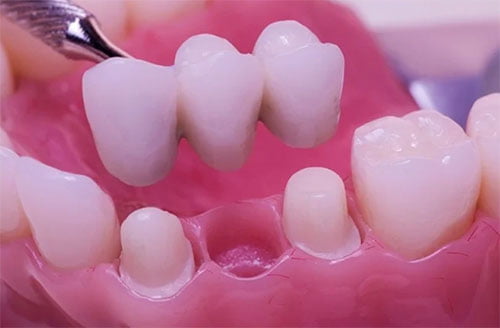 A traditional dental bridge is the most common, consisting of crowns fitted over teeth on either side of the gap, attached to one or more pontics between them. The result is a strong, stable dental bridge.
A traditional dental bridge is the most common, consisting of crowns fitted over teeth on either side of the gap, attached to one or more pontics between them. The result is a strong, stable dental bridge.
You can have a traditional bridge if the teeth on either side of the gap are strong and healthy enough to support it.
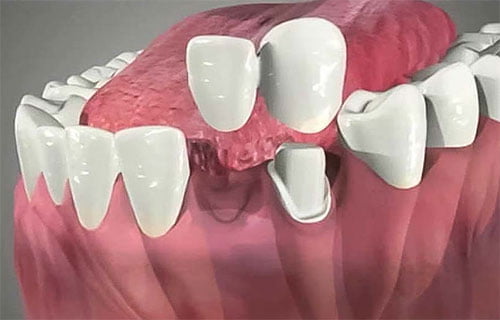 A cantilever dental bridge is only supported at one end by one or two teeth covered with crowns. The pontic extends across the gap and is unsupported on the other end.
A cantilever dental bridge is only supported at one end by one or two teeth covered with crowns. The pontic extends across the gap and is unsupported on the other end.
We might recommend this bridge if you only have teeth present on one side of the gap or when the teeth on the other side are not strong enough to use for support.
Due to their design, cantilever bridges are only used in specific circumstances where they are not subject to stronger chewing forces, as the lack of support on one side means they are weaker than a traditional bridge.
 A Maryland bridge, sometimes called a sticky or resin-bonded bridge, doesn’t rely on crowns fitted over adjacent teeth for support. Instead, metal or ceramic wings support the pontic between them. These wings are bonded onto the inner surfaces of teeth, so they are less visible.
A Maryland bridge, sometimes called a sticky or resin-bonded bridge, doesn’t rely on crowns fitted over adjacent teeth for support. Instead, metal or ceramic wings support the pontic between them. These wings are bonded onto the inner surfaces of teeth, so they are less visible.
A Maryland bridge is not strong enough to replace a back tooth, as it cannot withstand substantial chewing forces. Therefore we will only recommend this bridge if you need to replace a front tooth, such as a lower incisor.
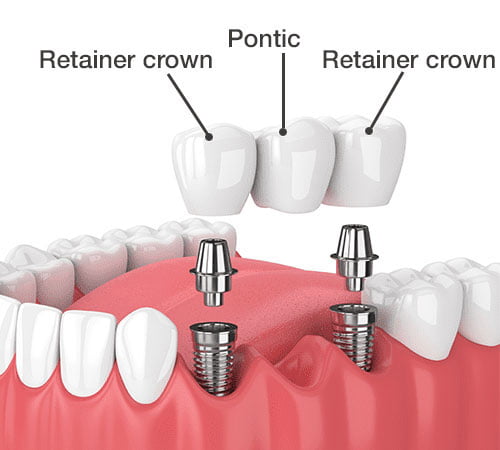 If three or more teeth are missing side by side, an implant-supported bridge can replace them. Two dental implants are inserted at either end and are covered with implant crowns attached to the pontics. An implant bridge is either cemented or screwed onto the implants and is non-removable. It is a good solution when multiple teeth are missing and where the natural teeth are not strong enough or not present to provide adequate support.
If three or more teeth are missing side by side, an implant-supported bridge can replace them. Two dental implants are inserted at either end and are covered with implant crowns attached to the pontics. An implant bridge is either cemented or screwed onto the implants and is non-removable. It is a good solution when multiple teeth are missing and where the natural teeth are not strong enough or not present to provide adequate support.
We consider several factors when determining which type of bridge might suit you best. The choice depends on the number of teeth missing, the condition of the adjacent teeth, your overall dental health, and of course, your preference.

Family Dentist
Brooklyn
Gravesend
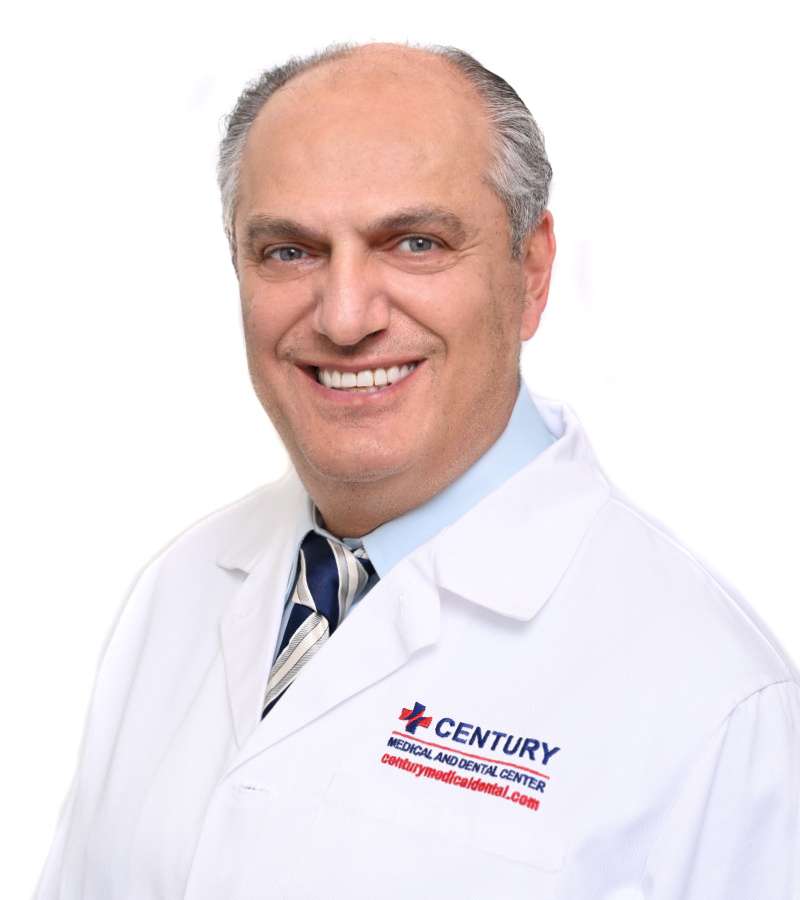
Family Dentist
Manhattan
Manhattan

Family Dentist
Brooklyn & Manhattan
Manhattan, Downtown

Dentist
Brooklyn & Manhattan
Gravesend, Manhattan, Downtown

Dentist
Manhattan
Manhattan

Dentist
Brooklyn & Manhattan
Manhattan, Livingston

Dentist
Brooklyn & Manhattan
Manhattan, Livingston
Dental bridges can be made from several materials described below.
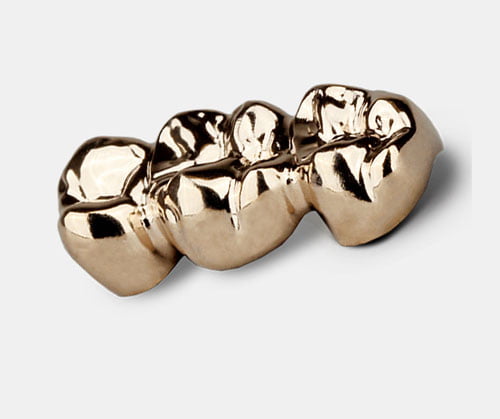 Metal alloy bridges can be polished to a high sheen and are strong, durable, and long-lasting but extremely visible.
Metal alloy bridges can be polished to a high sheen and are strong, durable, and long-lasting but extremely visible.
Therefore, we only tend to use these bridges to restore back teeth.
They used to be a good choice for people with teeth grinding issues since gold alloy will not damage the opposing Dentition. Nowadays, there are other alternative materials available.
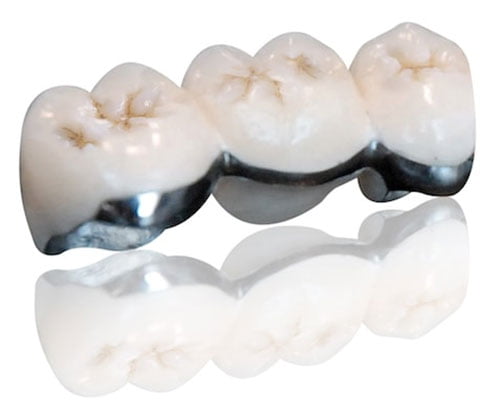 PFM bridges have a thin metal substructure covered with tooth-colored porcelain. The result is a durable bridge that blends in with natural teeth.
PFM bridges have a thin metal substructure covered with tooth-colored porcelain. The result is a durable bridge that blends in with natural teeth.
PFM crowns and bridges have been used for decades and are reliable but may not produce the best aesthetic results. This is due to the opaque porcelain used to cover the metal substructure that can be difficult to mask entirely successfully.
Also, over time if gums recede, it can expose the very edge of the abutment crowns, where porcelain is thinner and can create a gray line that looks less attractive.
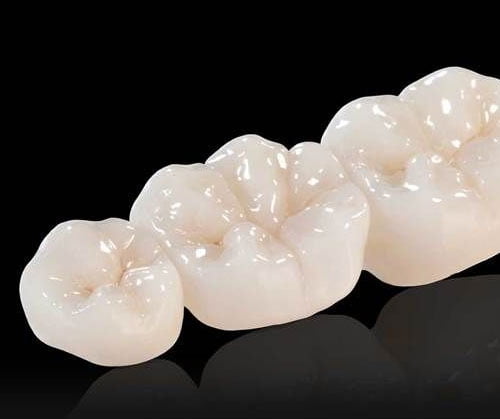 There are two types of ceramics available for dental bridges.
There are two types of ceramics available for dental bridges.
E-MAX
E-max, an extremely lifelike material that can look very natural, providing the best aesthetic results. It is ideal when restoring teeth right in the smile line, but e.max is only strong enough for three-tooth or three-unit bridges. It is not ideal for larger bridges or restoring back teeth that must withstand strong chewing forces.
Zirconia
Zirconia is another all-ceramic material that is much stronger and can provide extremely good results. Modern zirconia looks natural, has excellent translucency, and is suitable for use anywhere in the mouth. Zirconia can also restore back teeth in people with bruxism without harming the opposing teeth.
Jessica in particular, but wonderful service and good bedside manner overall. Likely the best dental service provider I’ve ever had. Soothing, informative and insightful. Thank you Jessica and the other staff for a positive and healthy dental health experience.
When considering dental bridges to restore dental function and enhance aesthetics, selecting a qualified dentist is essential. A specialist will ensure that the bridge is tailored to your needs, accurately fitted, and durable. A skilled dentist not only crafts a functional and natural-looking bridge but also takes into account your individual dental condition, ensuring a comfortable and long-lasting solution.
Our experienced dentists at Century Medical and Dental Center are experts in dental bridge procedures. By employing cutting-edge technology, such as the CEREC milling machine, we guarantee the best possible results for our patients. Furthermore, we provide affordable financing options.
The procedure depends on the bridge chosen to replace your missing teeth.
First visit
You will receive a local anesthetic to numb your mouth before our dentist carefully shapes the adjacent teeth in preparation for dental crowns to be fitted. It is necessary to remove this structure to ensure the crowns look and feel natural and are not too big and bulky.
Next, we take a dental impression and select a tooth shade. The information is sent to our dental laboratory, which will custom-make your new bridge to our prescription. It can take several weeks to make the bridge, so we fit a temporary dental bridge made from composite resin to protect your teeth.
Second visit
During your second visit, we remove the temporary bridge, try in your new bridge and check it fits correctly. Once we are happy with the fit and finish and you are satisfied with its appearance, the bridge is bonded in place.
First visit
We may need to prepare the inner surfaces of the abutment teeth for the wings before taking a dental impression. If this is necessary, we will only need to remove a small amount of tooth enamel. We will select a tooth shade and send the impression and the prescription to the dental laboratory so your Maryland bridge can be fabricated.
Second visit
Once the bridge is ready, you return to our dental office, and we will lightly etch the inner surfaces of the abutment teeth to create a slightly rougher surface. This allows for a stronger bond between the bridge wings and your teeth. We will try in the bridge, and once happy with the fit, it is bonded onto the inner surfaces of your teeth using special dental cement.
You will need several visits to our dental office for this treatment, as we must plan and place the implants, and they need time to heal and fuse with your jawbone during a process called osseointegration. Once healed, we attach special copings to the abutments to take a dental impression. We select a tooth shade, and the prescription and impression are then sent to our dental laboratory so they can fabricate your bridge.
When the bridge is ready, you return to our dental office, and we fit abutments onto the dental implants, which will support your new implant bridge. We try in the bridge, check it fits precisely, and attach it permanently in place.
An implant bridge can be cemented or screwed onto the dental implant abutments. The screws go through the bridge but are covered with tooth-colored composite resin. The reason for using this technique is so we can retrieve the bridge easily without damaging it or your dental implants if any maintenance is necessary later.
Caring for a dental bridge is straightforward. Using a soft-bristled toothbrush and good-quality fluoride toothpaste, you can brush and floss around the dental crowns like natural teeth. It is important to clean underneath your dental bridge each, as food and plaque can become trapped underneath the pontics.
You can use floss threaders or interdental brushes that slip underneath easily. We can show you how to clean your bridge and discuss suitable tools when you have it fitted.
Your regular dental checkups and hygiene appointments with Century Dental Center are very important. We can check the condition of your bridge and clean it professionally, helping to keep it looking good and protecting your oral health.
A dental bridge should last ten years or more, provided you look after it. Avoid chewing on pens, pencils, or nails; never use your teeth as tools. Good oral care and ongoing professional dental care will help it last longer.
The table displays the survival rates of different types of dental bridges over 5, 10, and 20 years. The data was published in the peer-reviewed Journal of Dentistry and Journal of Prosthodontics.
| Type of Dental Bridge | Survival Rate (5 years) | Survival Rate (10 years) | Survival Rate (20 years) |
|---|---|---|---|
| Porcelain-fused-to-metal bridge | 90% | 80% | 60% |
| All-ceramic bridge | 95% | 85% | 75% |
| Gold bridge | 95% | 90% | 85% |
| Metal-ceramic bridge | 90% | 80% | 70% |
* It is important to note the actual lifespan of a dental bridge can vary depending on a number of factors, including the materials used, the skill of the dentist, and the patient’s oral health habits.
References:
The cost of your new dental bridge depends on the materials chosen, the technique, and the number of teeth replaced. For example, tooth-supported bridges will cost less than implant-supported bridges, as an additional procedure is needed to plan and fit the implants. The implant components can be relatively expensive.
However, when comparing a dental bridge vs an implant bridge, it is important to consider that an implant bridge is self-supporting, so there is no need for our dentist to reshape teeth for crowns, an irreversible process. An implant bridge also provides a way to replace teeth when no suitable teeth are present to support a traditional bridge.
Still, not everyone is suitable for this treatment, and we will only recommend dental implants if there is an excellent chance of long-term success.
Since Century Dental Center accepts most dental insurance plans, including Fidelis Care, MetroPlus Dental, ElderPlan, Medicaid, and AARP Medicare Advantage, dental bridge, which are considered restorative treatment, are usually covered in full or at least partially depending on the technique and materials selected.
If you do not have dental insurance and paying from your packet, the average cost of a dental bridge ranges from $1000 to $10,000. The final cost is mainly influenced by the type of material used, technique and on the preparation methods.
When you visit Century Dental for a bridge, we can discuss all suitable options with you in more detail, show you examples, and provide accurate costs. We aim to provide you with the information needed to make an informed choice about your treatment so you receive a beautiful bridge that looks natural, is fully functional, and feels comfortable.
Century Medical and Dental Center is an accredited healthcare facility in NY that operates in accordance with Article 28, a public health law. This law regulates and recognizes accreditation for public healthcare facilities, ensuring they are licensed and operated correctly. By undergoing the Article 28 process and achieving accreditation, Century Medical and Dental Center demonstrates its commitment to meeting the highest standards of care.
As a multidisciplinary medical center, we have highly qualified doctors, nurses, and support staff who are working hard to provide the best medical care to patients in Midtown Manhattan, NY, Downtown Brooklyn, NY, including Brooklyn Heights, Dumbo, Prospect Heights, Park Slope, Clinton Hill, Boerum Hill, Red Hook, and Bedford-Stuyvesant.